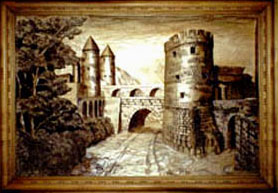
Leonid and Svetlana Zakurdayev were just visiting North America in 1999 when they decided to enter some of Leonid’s carvings in the International Woodcarvers Congress in Davenport, Iowa. The Moscow natives never traveled without Leonid’s carving tools, and, working quickly, they created three unique landscape relief carvings … something Leonid had never attempted before. They came away from the show with a wall full of blue ribbons and a lot of new fans!
Needless to say, Leonid was no ordinary wood carver. Back in the days of the Soviet Union, he’d graduated from Stroganov College of Artistic Design in Moscow with a degree as a Master Woodcarver and Restorer of Antique Furniture. It was a tough program to get into … admitting only six new students per year. Around the same time, Svetlana was earning an M.A. in Cultural Studies from the Institute of Culture in Perm and a Certificate in Interior Design from The Moscow School of Design. In 1996 they launched a successful business restoring and reproducing antique furniture, fireplace mantels, and church altars. In those days, all the projects came through the Russian government. But even the party apparatchiks were not without an appreciation for their work.
“We were so lucky to have intelligent clients who were interested in our work,” recalled Svetlana.
The collapse of the Soviet system was a painful time for everyone, the Zakurdayevs included. But the emergence of a business class brought new customers, and their business rebounded. By the end of the decade they could afford to regularly travel all around the world to see how other masters work. That’s what eventually brought them to the International Woodcarvers Congress.
“People asked who we were and where are we from?” recalled Svetlana. “They told us it was nice to see European-style carving and asked if we could stay in the country and show more of our work. Everyone we met was so nice, we decided to try and stay.”
With the help of an immigration lawyer, the couple quickly gained a special artist’s visa and settled into St. Paul, Minnesota. The notorious Minnesota winter didn’t faze them, but it was hard starting a new business and learning better English.
“We have the same weather in Moscow,” explained Leonid. “We had some doubts, but it seemed like destiny to change our lives and struggle for something. We could not just live anywhere, place is important. It takes time to build up a reputation and get people to trust you.”
o help build that reputation, the Zakurdayevs attended the prestigious Philadelphia Furniture and Furnishings Show this spring and were honored to be one of only eight entrants accepted in their category. The East Coast has been a good market for their work, but they’ve found the biggest market for Leonid’s mostly Art Nouveau-inspired pieces back in Minnesota’s Twin Cities. The local carving community has been equally supportive, including Nathan Stanley; a carver featured last winter in this eZine, whom they helped move into his house.
They start working a project by creating a series of quick sketches. The concepts are usually based on fluid, organic, Art Nouveau imagery, but they can create Baroque, Gothic or any other style to suit the customer. With the client’s sign-off, Leonid creates a full-sized drawing of the finished piece. He prefers working with basswood or butternut, but for furniture will tackle the harder, but more practical walnut. Some of their wood comes from Youngblood’s lumberyard in North Minneapolis, but lately they’ve been getting great carving wood from John Krantz in Forest Lake, Minnesota. To create the thickness he needs, Leonid will laminate several pieces together. When he’s ready to carve, Leonid has a large selection of chisels and gouges, some from the old country, others from all over the world and but his favorites are those made in Switzerland because of their ability to hold a sharp edge. Though Leonid works quickly, elaborate furniture can take up to a year to complete and so they are usually paid 50% up front. And the couple readily admits that only high-end customers can afford their work.
“We could not be starving artists!” laughed Leonid. “And if we attempted to make simpler, less expensive pieces, we’d never be able to compete against the mid-range imported and factory furniture.”
Their next project is a joint effort with local woodworker John Nesset. The couple is creating some Celtic designs as part of one of John’s benches. They are also developing a new line of room dividers that may feature Svetlana’s batik work. Regardless of the piece, its quality and even perfection are always paramount in their minds.
“We put our heart and soul into our work,” Leonid explained, “so that the people who look at our work receive back our mood and our kindness.”





